Recently, on a TV news channel while covering an event on Kashmir, reporting from Srinagar the reporter said that ‘Though Kashmiri Pandits have left the Valley, they had cornered most of the jobs in Kashmir’.
It may be pointed out that the militant organisations and their overground supporters had and continue to carry out massive disinformation campaign to justify violence against Kashmiri Pandits, which ultimately led to the community’s exodus from the Valley. However, the reality is different and the issue has been covered in detail by Col Tej K Tikoo, Ph.D. in his much acclaimed book, Kashmir; its Aborigines and Their Exodus. Here are the excerpts:
The argument that it was economic deprivation of Kashmiri Muslims which forced the poverty-laden youth to take up arms, has been repeated ad nauseam by the vested interests. Pakistan and its sympathisers propagated this argument to camouflage the real intentions of the Islamists. The Indian political parties that supported this view did so to protect their vote banks. Population figures of various communities in the state, based on 1981 census, are given below. As the militancy broke out in Kashmir some years later, these population figures will serve as a benchmark to assess the ‘truth’ of the economic reality of the state.
The Hindu population shown above did not include 2,50,000 Hindu and Sikh refugees, which formed nearly 4.2 per cent of the population.
The total population of Hindus, Sikhs and Buddhists (including 4.2 per cent of the refugees) was 40.18 per cent. Per capita growth from 1970–71 to 1985–86 went up from Rs. 548 crores to Rs. 2204 crores at current price and from Rs. 548 crores to 683 crores at constant price of 1970–71. Within the state, Kashmir with its overwhelming Muslim population, was allotted between 65–69 per cent of the financial resources, compared to 31–35 per cent to Jammu and Ladakh together.
…the militant organisations and their overground supporters had and continue to carry out massive disinformation campaign to justify violence against Kashmiri Pandits…
The Kashmiri Muslims owned 97.4 per cent of the agricultural land. The Hindus and other minorities had to be content with 2.6 per cent of the remaining land, though they comprised 11 per cent of the population in Kashmir. The former owned 96 per cent of the fruit orchard acreage in Kashmir, against 2.8 per cent by Hindus. Similarly, the Kashmiri Muslims owned 98.7 per cent of karewas (highlands), growing saffron, compared to 0.03 per cent owned by Hindus. Besides this, the export of dry fruit (almonds and walnut) and precious walnut and willow wood, was completely monopolised by the Muslims. The Hindus had almost no share in it. There were nearly 48,100 orchard holdings, employing an estimated 800,000 people, out of which Kashmiri Pandits formed a minuscule number estimated to be less than 0.5 per cent. Due to its complete monopoly of Kashmir’s agricultural sector, the Kashmiri Muslims appropriated 94 per cent of the subsidy paid by the state on horticulture, agriculture, agricultural implements, fertilisers, pesticides, etc. Hindus received less than 2.4 per cent of this subsidy.
98.9 per cent of the industries using electric power were owned by Muslims, with Hindus owning just 0.02 per cent. Same situation existed in handloom and handicraft industry in Kashmir, which was almost entirely owned by Muslims. This industry provided employment to 91,941 persons, nearly all of them Muslims. Hindus formed 0.4 per cent of the total employees. In 1985–86, when Muslims in the valley were getting radicalised, the membership of the handlooms and handicraft cooperative societies stood at 17,776. Out of this, only 0.3 per cent was owned by Kashmiri Hindus. In the same year, out of the 46, 293 industrial units registered with the directorate of industries in Kashmir province, 98.7 per cent were registered in the name of Muslims and 0.01 per cent in the name of Hindus. 98.8 per cent of the total of 28,110 employees of the industries registered under Khadi and Village Industries Board, were Muslims.
Out of a total of 450,000 government/semi-government employees in the State, 330,000, come from the Valley.
In the absence of railway network in the state, road transport played a vital role as the primary source of travel and communication within and outside the Valley. Even in this sector, the ownership of the transport and transport companies was monopolised by Muslims, with Sikh ownership standing at 4.2 per cent. The Hindus of Kashmir were negligible stakeholders in the transport sector. In 1985–86, even in the state-owned Jammu and Kashmir State Road Transport Corporation (JKSRTC), Kashmiri Hindus accounted for only 0.8 per cent of its total number of 6,434 employees. The state government had floated some schemes for providing loans (and subsidies on such loans) for establishing industries, self-employment enterprises, exports unit, handicraft and small scale units (and purchase of land for such enterprises, etc.). The beneficiaries of these schemes were almost entirely Kashmiri Muslims, with Hindus receiving barely 0.1 per cent of the entire amount.
Boats of various types and sizes played an important role in transportation through inland waterways and in tourism industry of the state. The entire fleet of these boats, including the luxury houseboats, was owned by Muslims. Number of various types of boats existing and the employment provided by these in 1985–86, are given in the chart below. Today (July 2011) the number of luxury houseboats is little over 1,200.1
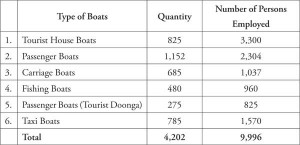 The tourist industry in Kashmir also depended heavily on the network of hotels. 96 per cent of these hotels were owned by Kashmiri Muslims, compared to 2.2 per cent owned by Hindus.
The tourist industry in Kashmir also depended heavily on the network of hotels. 96 per cent of these hotels were owned by Kashmiri Muslims, compared to 2.2 per cent owned by Hindus.
Even in the awarding of contracts for various developmental projects, including public works, Kashmiri Hindus, at an average, received about 4 per cent of these. Similarly, till 1979, when the contracts for the exploitation of forest products were given to private individuals, the Hindu share of receiving these contracts was only 6.2 per cent. After 1979 these were nationalised. Other income generating sources, like issue of licenses for quarrying, mining of marble, establishing brick kilns and manufacture and export of carpets and shawls, were completely in the hands of Kashmiri Muslims.2
During militancy, Kashmir has prospered economically and is far better placed than most other states of India. Besides Punjab, Kashmir is the only other place, where most agricultural operations are undertaken by hired labourers…
For years the vested interests carried out a sustained propaganda that the State of Jammu and Kashmir lagged behind other states of India economically, as it faced step-motherly treatment from the Central government. However, the facts indicated otherwise. In the crucial years preceding the outbreak of violence in Kashmir, the state was (and continues to be) way ahead of other states, on every parameter that determines the economic well-being of a state. In fact, Kashmiris themselves find the ‘theory of their economic deprivation’ as the cause of their uprising, as laughable. After all, economically deprived people are not voracious meat eaters, as Kashmiris are. “On an average, 3.5 million goats are slaughtered annually for consumption in Kashmir.”3
During militancy, Kashmir has prospered economically and is far better placed than most other states of India. Besides Punjab, Kashmir is the only other place, where most agricultural operations are undertaken by hired labourers from Bihar and Orissa since long. Among other things, it is the only place where education is free from elementary to professional and university level; where per capita saving and per capita consumption of animal proteins is the highest in India; it also ranks highest in the expenditure incurred on clothing. It is also, perhaps, the only place where everybody owns a house. Some other parameters too are revealing. According to the study carried out by National Sample Survey Organisation in 2009, the average household has assets worth almost Rs. 11,00,000 the highest in the country. Kerala follows with the average household assets being worth a little over Rs. 7,51,000. Experts say that even though there are no major industries in the state, income is more evenly distributed in Jammu and Kashmir than in any other part of the country. Says Haseeb Drabu, former Chairman of Jammu and Kashmir Bank, “It’s the only place in the world where the most radical land reforms were initiated in a non-communist regime. It even pre-dates the land reforms carried out in Kerala. Therefore, you find that average Kashmiri’s asset base is much better than the average person in the rest of the country. Agrarian sector, especially horticulture, is doing well. Land has provided a resilient economy.”
Even though the tourist industry crumbled due to rising militancy in nineties, the economy did not collapse…
It was believed that economically Kashmir is so heavily dependent on tourist industry that the disturbed conditions during the past two decades would destroy its economy. But these beliefs have been proved unfounded. The disturbed conditions in the valley have, if anything, improved the economic well-being of the people in the state. Even though the tourist industry crumbled due to rising militancy in nineties, the economy did not collapse and land prices continued to rise. “There was an impression that Jammu and Kashmir survives only on tourism, and once tourism goes down, the economy will crumble. It’s not so.
There is very large agrarian sector, which has done very well,” said Haseeb Drabu. “Since the beginning of militancy in 1990, the state has managed to get the lion’s share of Central resources; Rs. 35,571.3 crores in grants and assistance.”4 “Between 2000–2003, it got Rs. 13,188 crores which is more than three times what India’s poorest state, Bihar, got; Rs. 4,047 crores. When you consider that of the Rs. 14,085 crores net resource transfer by the centre, Rs. 13,188 crores was grant, you will get an idea of the magnitude of dole that Jammu and Kashmir gets. A similar economic revival plan for Bihar would amount to Rs. 47,458 crores!”5 (See Table 1 and 2 below):-
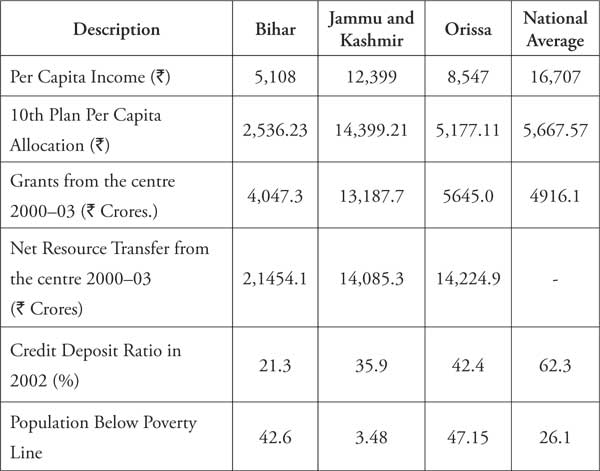
Table 1: Economic Profile. Source: Planning Commission, Government of India, Reserve Bank of India, State Finances 2002–03 and Statistical Outline of India 2002–03.
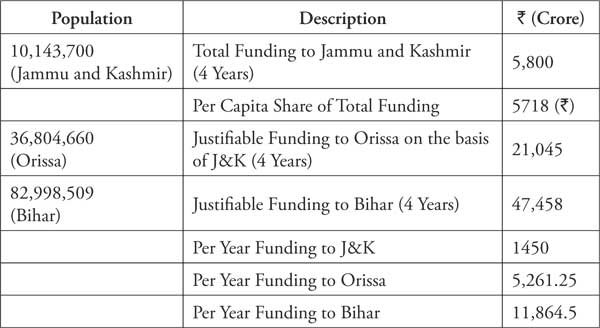
Table-2: Prime Minister’s Economic Package applied to two Most Backward States. Source: Census of India 2001 and Calculation on the basis of available figures.
A Kashmiri understands quite well the massive economic benefits that accrue to him as a result of his being part of India. “A Kashmiri gets eight times more money from the centre than citizens from other states. While per capita central assistance to other states moved from Rs. 576.24 in 1992–93 to Rs. 1,137 in 2000–2001, that of a Kashmiri spiralled from Rs. 3,197 to Rs. 8,092.”6
“To put this in perspective; if the aid given by the Central government to the State were to be distributed to each family (of 5 persons); they would get Rs. 40,460 every year. Per capita consumption has also shot up from Rs. 134/month in the eighties to Rs. 746/month in 2000.”7 It is interesting to note that Jammu and Kashmir has the lowest poverty level in India: in 1990, the percentage of people ‘below poverty line’ (BPL) was 25.17 per cent, which dropped to 3.48 per cent in 2000. Compare this with 26.10 per cent in whole of India. This, despite the fact that the State’s contribution was less than 1 per cent of the GDP in 2000–2001. “In 2001–2002, the state spent Rs. 7516.6 crores, of which Rs. 4,577, (or 60 paise of every rupee spent came from centre). The state’s non-developmental expenditure was Rs. 2,829 crores, including its salary bill of Rs. 1,193 crores, while its own revenues were barely Rs. 1,095 crores. The state could not have paid even the wages of its employees without the centre’s help.”8 In other states, central assistance comprises 70 per cent debt and 30 per cent aid; in Jammu and Kashmir it is 90 per cent aid and 10 per cent debt. Later, even this 10 per cent debt was converted in to aid. In fact, the centre is funding the complete Five-Year-Plan of Rs. 11,400 crores.
The state is also quite well off in other socio-economic fields as indicated by the following facts:-
- Its literacy level at 64.8 per cent and sex ratio of 923/1000 is almost at par with the national level of 65.4 per cent and 933/1000 respectively.
- Its birth rate of 19.9/1000 is lower than the national average of 25.8/1000. So is its death rate; 5.4/1000 for the state compared to 8.5/1000 of the national average.
- Jammu and Kashmir’s infant mortality rate (45/1000) is also superior to the national average (68/1000). See Table:-
The official per capita income of Jammu and Kashmir in 2002–2003 was Rs. 12,399. This was lower than the national per capita income of Rs. 16,707. But it is much higher than many other states; Bihar — Rs. 5108, Orissa — Rs. 8547. “For the 10th Five Year Plan, the state got a per capita allocation of Rs. 14,399 whereas Bihar and Orissa got Rs. 2,536 and Rs. 5177 respectively, while the national average was only Rs. 5668.”9
The Jammu and Kashmir Government employs 350,000 people, which translates to 34.5 government employees for every thousand persons. Rajasthan Government on the other hand, employs less than double the number of people, despite being about five and half times bigger than Jammu and Kashmir in terms of population.

Table 5: Government Employee Status. Source: Census of India and Statistical Outline of India, 2003–04 *www.jammukashmir.nic.in. (Website of Govt. of J&K). **Rajasthan Plans Computer Training for Employees, 8.11.2004; Indo-Asian News Service, Jaipur.
“In 2002–2003, it raised a mere Rs. 936 crores by way of taxes and had total non-tax revenue of Rs. 4,745 crores. Bihar collected Rs. 2,814 crores by way of taxes and had total non-tax revenue of Rs. 2,062 crores. Quite clearly, therefore, the nation’s munificence is lavished upon Jammu and Kashmir.”10 This appears quite unfair considering the fact that “the State government’s accounts have not been audited for over a decade. No one knows what was spent where and who got what.”11

Table-6: Tax Mobilization in States in 2002-03 (Rs. in Crores). Source: State Finances, Reserve Bank of India, 2002–03. Note: Tables 1 to 6 have been reproduced from a report authored by Centre for Policy Alternatives (CPAS); a privately funded think-tank focussed on the study and review of Public Policy in India
All security-related expenditure of the State is also reimbursed to the State by the centre. 5,50,000 security forces personnel deployed in the State have also contributed to the flourishing economy of the State. To add to their (Kashmiris) income, “Income Tax and Sales Tax are hardly ever paid and rarely demanded. The phenomenon pre-dates terrorism,” says Anand K Sahay.12
Jammu and Kashmir did not bank with Reserve Bank of India, but with its own Jammu and Kashmir Bank, wherein it owned majority stake and from which it could obtain overdrafts.
According to National Sample Survey Organisation, urban parts of Jammu and Kashmir have prospered during the period of militancy. Jammu and Kashmir also has many other advantages compared to other states of India. It enjoys a far greater degree of autonomy than any other state in India through its own constitution and privileges guaranteed by Article 370 of the Constitution of India. Jammu and Kashmir did not bank with Reserve Bank of India, but with its own Jammu and Kashmir Bank, wherein it owned majority stake and from which it could obtain overdrafts. Recently this arrangement has undergone a change. Through an agreement that the State reached with the Reserve Bank of India on January 21, 2011, the latter “will undertake all its general banking business and act as its sole agent for investment.”13 This agreement came into effect from April 1, 2011.
As would be evident, terrorism itself has created a huge economy and powerful lobby of vested interests. For them, keeping the pot boiling makes great economic sense.
Valley’s Dominance of State’s Economy and Politics
Ever since its accession to India, the political dispensation governing Jammu and Kashmir, has been completely dominated by the of State’s Muslim majority legislators who belong to the Valley. Irrespective of their party affiliations Kashmiri Muslim legislators zealously guard the interests of the Valley’s Muslims. The Central government has all along been a willing and enthusiastic accomplice in this communal agenda of theirs. To quote an example, on March 25, 2011, a government order entitled Dogras of the State (basically from Jammu) to obtain a Dogra Certificate which envisaged some relaxation in rules governing their recruitment into Central Para Military Forces, in terms of some physical measurements. However, the separatists created a hue and cry, terming it as a prelude to creating a Duggar Desh (Dogra State).Taking a cue from the separatists, the Muslim legislators then ganged up, with the active connivance of the Central government, to have the order revoked a month later; on April 28, 2011. That the State government had bowed in front of the separatist’s communal agenda, supported by the Indian Government, was not the first such instance. It is because of this ganging up by Kashmiri Muslim legislators that the decks in every sector within the State are tilted heavily in favour of Kashmir.
Jammu comprises an area which is 70 per cent larger than Kashmir and has 45 per cent of the State’s population. But Jammu has only 37 seats in the State Legislative Assembly, whereas Kashmir has 46. Jammu returns one member to the state legislature for 90,000 people, whereas in Kashmir, it is 73,000 people who return one such member. This, despite the fact that Jammu region has more registered voters (30,59,986) than the Valley (28,85,555). Average size of Parliament and Assembly seat (in terms of voters) in Jammu is 12,31,000 and 66,600 respectively; in the Valley these figures are 8,03,000 lakh and 52,400 respectively. Kashmir gets to elect three members for the Parliament and Jammu only two.
In late eighties, two million people visited Vaishno Devi Shrine every year compared to half a million tourists visiting Kashmir. Yet 90 per cent of the tourism budget was allotted to Kashmir.
Jammu contributes 70 per cent of the State’s revenue, whereas only 30 per cent of its total expenditure is incurred on it.
Out of a total of 450,000 government/semi-government employees in the State, 330,000, come from the Valley. Jammu and Ladakh are grossly under represented; the former having only 15 per cent representation in the civil secretariat. At the secretary level, Jammu’s share is 8 per cent. Ladakh’s representation in civil secretariat is only 0.68 per cent. The unemployment figures in Jammu and Ladakh are 69 per cent, which is far higher than that in the Valley, where it is 30 per cent (2006 figures). Between 1990 and 2006, state government employed 265,000 persons; only 345 of these were Kashmiri Pandits.
Jammu contributes 70 per cent of the State’s revenue, whereas only 30 per cent of its total expenditure is incurred on it. Since 1996, the state created 155,000 job opportunities; Jammu got only 15,000 of these, remaining went to the valley. “At an average, 6000,000 tourists visit Jammu every year and only 200,000 visit Kashmir, yet 90 per cent of tourism expenditure goes to the Valley,” says Dina Nath Mishra.
The discrimination against Jammu and Ladakh is further compounded when even developmental works are carried out with a heavy bias towards the Valley. As Dr Hari Om, writing in the Indian Express of July 17, 2002 states, “Chenani is the only power project in Jammu, producing a paltry 22 MW of power. The rest of the projects, Upper Jhelum, Lower Jhelum, Upper Sindh, Mohra and Ganderbal, etc. are all in the Valley, with a production capacity of 328 MW. While only Rs. 10 crores has been spent on Chenani project, Rs. 500 crores has been spent on the Kashmir plants.” Major factories like the cement factory, Hindustan Machine Tools and telephone factory, are all located in Kashmir itself. Writing about the state of other infrastructural projects, Hari Om states, “Jammu has a total area of 26,293 sq kms and Kashmir 15,853 sq kms. In 1987, Jammu had 3,500 kms of roads, covering 18 per cent of this area, whereas Kashmir had 4,900 kms, covering more than 40 per cent of the area.”
…Jammu had 3,500 kms of roads, covering 18 per cent of this area, whereas Kashmir had 4,900 kms, covering more than 40 per cent of the area.”
The tilt towards the Valley extends to even the number of professional colleges and technical institutes opened in the State. Whereas Kashmir boasts of Post-graduate Sher-e-Kashmir Institute of Medical Sciences, dental college, veterinary college, Agriculture University, Regional Engineering College, the Artificial Limb Centre, Institute of Hotel Management and Physical Training Institute: Jammu has one ill-equipped medical college and a small under-staffed engineering college which does not even have a full range of equipment. The agriculture and Ayurvedic colleges in Jammu have been closed down. In the admissions to Regional Engineering College and Agricultural University, the share of Jammu province is only 30 per cent.
Mata Vaishno Devi University was established in Jammu after the proposal was rejected by the government on many occasions, on one pretext or the other. Even when the proposal was finally accepted, the university was set up by the Vaishno Devi Trust, using funds collected from pilgrims. The Trust had to shell out Rs. 13 crores to purchase the land at commercial rates. On the other hand, Baba Ghulam Shah Badshah University, set up as a counter move in Rajouri, was funded by the State Wakf Council headed by Mufti Mohammad Syed, the then Chief Minister, who also gave it a huge chunk of forest land, free of cost.
In 1986, the Prime Minister announced an aid package of approximately Rs. 180 crores for the state. Out of this, Jammu got Rs. 15.5 crores, and Kashmir, Rs. 70.06 crores. The remaining amount of Rs. 92.76 crores was meant to be spent on the common development projects of the entire state, but actually it turned out that more than Rs. 50 crores was allocated to Kashmir.
…economic advantages enjoyed by the Valley Muslims, Kashmiri Pandits exodus from the valley in 1990 has further improved their economic status.
To add to all these economic advantages enjoyed by the Valley Muslims, Kashmiri Pandits exodus from the valley in 1990 has further improved their economic status. Huge chunks of agricultural and non-agricultural land left behind by Pandits (some estimates put it at 14,000 hectares of agricultural land alone) has been illegally appropriated by them. Besides, continued life in exile compelled a large number of Pandits to resort to distress sale of their properties. “99 per cent of the sale of houses by Pandits was termed as distress sale.”14 Such distress sale, particularly in the initial years of militancy, further contributed to enriching the Kashmiri Muslims. A clear indication of improved economic status of Kashmiri Muslims is the fact that in every home, whenever there is some function, jewellery is presented as gifts to the guests. “Now, even diamonds are becoming popular. It was not so earlier,” says Nisar Ahmed, a shop-owner.
Additionally, what contributed substantially to the economic betterment of Kashmiri Muslims was that they got to fill-in thousands of government posts which were created as a result of Pandit’s exodus from Kashmir. Besides, the posts vacated by Pandits in the State government services while retiring every month, too got filled by Kashmiri Muslims as none was recruited from amongst the former. By 2007, approximately 72 per cent of state government Pandit employees had retired and these posts were filled up by Kashmiri Muslims. After more than two decades of their exodus, the State government, on instructions from the centre, has recently recruited 3,000 Pandits, though their service conditions stipulate that they need to serve in Kashmir. How many will take up these jobs is, therefore, a moot point.
It is because of all these reasons that one does not get to see the same stark poverty in Kashmir Valley, as one gets to see in the rural areas of rest of India.
The combined grant received by the eight north-eastern states during the same period was Rs. 29,084 cores; 44 per cent of their entire expenditure. This is significantly lower than that of Jammu and Kashmir.
Compare this with PoK, if only to bring out the fact that Kashmiris are better off than those living across the LoC. World Bank report of July 2002, stated that 88 per cent people in PoK live in rural areas, depending on forestry and agriculture. Unemployment ranges between 35 to 50 per cent. Literacy, till recently, was only 10 per cent, though it has now risen to 48 per cent. Sixty per cent of the population has no access to drinking water. Whereas, per capita income of Pakistan was 420 $ (Rs. 21000) in 2006, in PoK it was 185–200 $ (Rs. 9,500).
Present Economic Realities of the State
Government of India has poured in thousands of crores of rupees into the State in the past two decades of insurgency, to help some specific sectors, like tourism, which were hard hit by insurgency. Before militancy set in, tourism contributed Rs. 500 crores per annum to the State’s economy. The tourist inflow, which had reached a peak of 730,000 in 1978–79, was reduced to a few thousand after violence broke out in Kashmir. Public infrastructure also suffered great damage due to neglect and violence. Between 1989 and 1996, about 725 educational institutions and 303 bridges and culverts had been destroyed. The negligible recovery of taxes and revenues during the nineties further increased the non-plan deficit. Consequently, the State’s economic dependence on the centre further increased in the recent past.
Reserve Bank of India’s figures (2009–2010) clearly point out the deep financial mess the State is in. In 2009–2010, it received 60 per cent of its total expenditure, amounting to Rs. 13,252 corers, as grants. Between 1989–90 and 2009–2010 (militancy period), the state received a total of Rs. 94,409 crores, as grants. During the decade between 1994–95 and 2005–2006, the state got 10–12 per cent of the total amount disbursed as grants to all the states of the country. Though, in 2009–2010, it had marginally dipped to eight per cent. Such high level of grants, compared to its ratio of the entire population of the country (nearly one per cent) proves that the Central government has been more than kind to the State. The inflow of goods into the Valley also increased from Rs. 1,157.33 crores in 1989–90 to Rs. 2,536.53 crores in 1994–1995 (the worst period of militancy). During the same period, the outflow of goods from the Valley also increased by nearly 50 per cent.
Only 30 per cent of the aggregate expenditure of the State is incurred on social sectors, i.e. schools, health and rural development — fourth lowest among all states. This is against the national average of the 40 per cent.
Compare this with the centre’s attitude towards the perennially insurgency-hit north-east. The combined grant received by the eight north-eastern states during the same period was Rs. 29,084 cores; 44 per cent of their entire expenditure. This is significantly lower than that of Jammu and Kashmir.
Mis-utilisation of these funds by Jammu and Kashmir has often raised many eye brows. Only 30 per cent of the aggregate expenditure of the State is incurred on social sectors, i.e. schools, health and rural development — fourth lowest among all states. This is against the national average of the 40 per cent.
Despite militancy being at peak during 1990–1995, 6,428 villages were brought under new water supply scheme, besides executing two master plans for Jammu and Srinagar, respectively. Similarly, handicraft production in Kashmir Valley, which in 1974–75 was Rs. 200 million, rose to Rs. 2,400 million in 1993–94. Export of handicrafts also registered a jump from Rs. 75 million to Rs. 2,130 million during the same period. In 1993–94 alone, 3,617 health centres were set up. The enrollment of primary school students also went up from 745,000 in 1989–90 to 940,000 in 1994–95. The State employs 350,000 people, whereas Rajasthan, which is five times the size of Jammu and Kashmir employs only 600,000 people. For the Tenth Five-Year Plan, it got a per capita allocation of Rs. 14,399, compared to Rs. 2,536 for Bihar and Rs. 5,177 for Orrisa.
Administrative expenditure of Jammu and Kashmir is nearly 12 per cent of its overall expenditure. Some might argue that such high level of expenditure is attributable to the State’s mountainous terrain and its disturbed conditions. But Himachal and Sikkim, both mountainous regions, spend only six per cent on administrative expenditure. Another pointer to the woeful state of financial affairs of the state is its per-capita spending. In Sikkim, Mizoram and Arunachal Pradesh (all mountainous states and also affected by militancy in varying degrees), the per capita spending is Rs. 59 lakhs, Rs. 35 lakhs and Rs. 38 lakhs, respectively (figures for 2009–2010). In Jammu and Kashmir, it is only Rs. 20 lakhs. This clearly shows that not enough money is being spent by the State on projects that would have benefited the people directly. One of the reasons is that the State is not generating enough revenue of its own. Besides, there are legitimate doubts whether even the money being shown as spent, was in fact spent at all. Incidentally, not long ago the State was rated as the second most corrupt state among all Indian States by the Berlin-based International Corruption Watchdog, ‘The Transparency International.’ As Mohan Guruswamy and Jeevan Prakash Mohanty have stated, “Talk to even the most ardent pro-India Kashmiri, and he will tell you that politicians and bureaucrats have stolen most of the money. Lending credence to this is the amazing explosion of new construction in evidence all over Kashmir Valley. It is believed that every second house belongs to a government employee or one connected with it. Relate this to the low poverty level in the State and it would seem that trickle-down economics works.”15
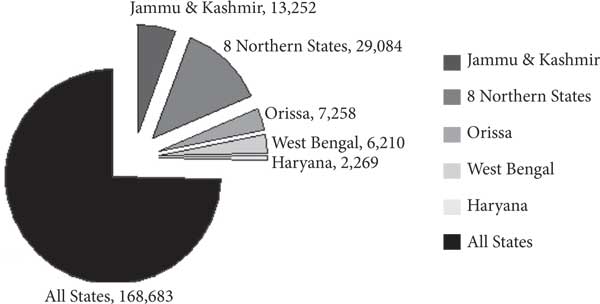
Grants from Central Govt. (Rs. in Crores): Share of Total State Expenditure (%). Source: Times of India, July 19, 2010
That the so-called economic backwardness was the cause of breaking out of insurgency in Kashmir has been refuted by no less than its youthful Chief Minister, Omar Abdullah. Speaking on the occasion of inauguration of Qazigund-Anantnag railway line on October 28, 2009, he said, “Kashmir issue cannot be resolved through the flow of money. It was the politics, not the urge for money that drove the Kashmiri youth to take up arms twenty years back.”
Notes
1. House boats are synonymous with tourist industry in Kashmir. Tourists live in these magnificent boats, anchored in the serene and placid waters of Dal and Nagin lakes of Kashmir. Incidentally, it was a Kashmiri Pandit, Narain Das, who constructed the first house boat in Kashmir. “Narain Das was one of the first five Kashmiris to learn English from Rev. Doxy, the founder of famous Kashmir Mission School in 1982,” says the book Keys to Kashmir. He was the father of the renowned Shaivite philosopher of recent times, Swami Laxman Joo. Narain Das had opened a small store to cater to the needs of European visitors, who had started flocking to Kashmir in large numbers at the turn of nineteenth century.
Once his store was destroyed in fire, and not finding a suitable place to run the strore from, he shifted to a doonga. This shifting turned out to be a blessing in disguise as the doonga could be moved to a convenient location for visitors and moored there. When rain and snow destroyed the matting walls and hay roof of his new store, he replaced these with wooden planks and shingles. A British officer once took fancy to his doonga and purchased it from Narain Das, who found the deal quite profitable. Thereafter, Narain Das started constructing doonga and gave up the business of running stores.
Narain Das had also developed trade relations with some companies belonging to Western countries. One of these was Koch Burns Agency, which too ran a departmental store from a doonga, parked on the Jhelum, near Shivpora in Srinagar. “In 1885, the Koch Burns Agency shifted to Chinar Bagh near Dalgate. Once a customer of the Agency, Dr Knight, suggested to Narain Das that he should make some modifications to the doonga to make it more attractive and convenient for the tourists to live in,” says Inder Krishen Raina, a grand nephew of Narain Das. The latter found the idea interesting and carried out the required modifications. By July 4, 1890, after much trial and error, the first house boat was ready for commercial use of tourists. However, constant improvement in design and aesthetics continued till many years thereafter. With vital inputs from Colonel R Sartorius, V.C., and some other Englishmen, the first double storey house boat, named ‘Victory’, was constructed in 1918. This had led to Narain Das being known by the nick name Nav Narain (Nav, meaning boat).
The boats are made of quality cedar wood available in deep forests of northwest Kashmir.
2. Dr MK Teng and CL Gadoo, White Paper on Kashmir for Joint Human Rights Committee for Minorities in Kashmir (Gupta Print Services).
3. Binish Gulzar and Syed Rakshanda Suman; Pioneer, August 25, 2009.
4. Shankar Aiyer, India Today, October 14, 2002, p. 36.
5. Mohan Guruswamy and Jeevan Prakash Mohanty, Jammu and Kashmir: Is there really a fresh vision and a new blueprint? Centre for Policy Alternatives (CPAS), New Delhi.
6. Shankar Aiyer, n. 4.
7. Ibid.
8. Ibid.
9. Mohan Guruswamy and Jeevan Prakash Mohanty, n. 5.
10. Ibid.
11. Joginder Singh, Pioneer, February 11, 2008.
12. Inside Kashmir-3, Times of India, August 2, 2010.
13. Times of India, January 22, 2011.
14. Prof Hari Om, Kashmir Sentinel, December, 2006.
15. Mohan Guruswamy and Jeevan Prakash Mohanty, n. 5.




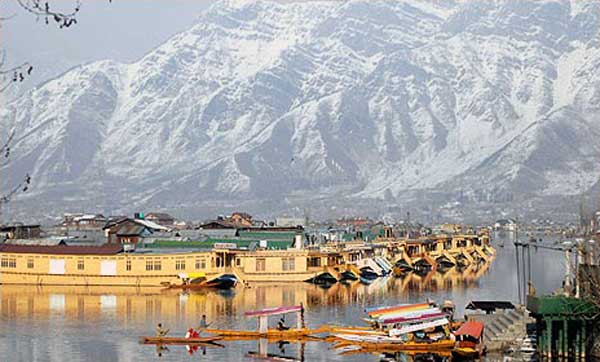


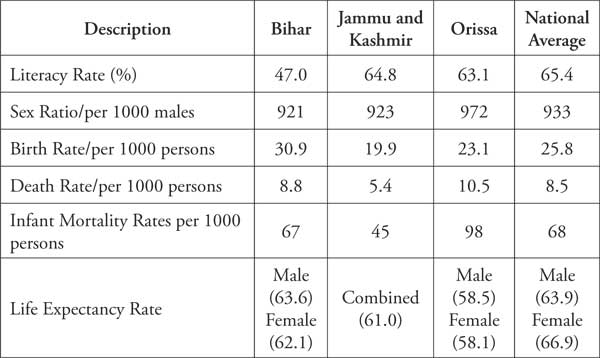
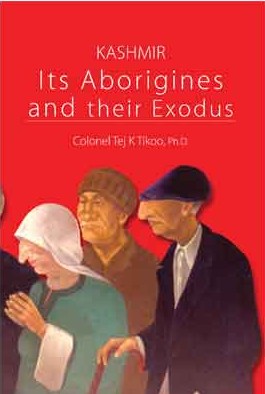

article clearly shows how shrewdly porki sympathizers in Kashmir conspired against Kashmiri Pandits and we had no clue what was going on there .all the political parties at center are responsible for Ignoring plight of Kashmiri Pandits my heart goes out for them ,i am really sorry as an Indian and as an Hindu